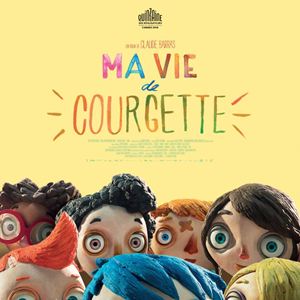My Life as a Zucchini ( Claude Barras, 2016) France
Reviewed by Pierre Balloum at the Santa Barbara Film Festival
As an author’s animation unfolds, it invests new fields: the study of morals for adults with Anomalisa, the contemplative philosophy in the Red Tortoise, the aesthetic study with Tout sur haut du monde … As much of Evidence that this genre is not limited to mass childish entertainment in which intermittent parody or ironic elements intended for adults. My life of courgette, realized in stop motion for almost two years, obeys the same ambition: to tackle at the head difficult issues, such as childhood in the home, the abandonment or the death of the parents, and the delicate mechanisms of the Reconstruction. The bias is, however, not to directly address adults, by letting the children speak, by filming at their height, and letting them express in their own way the flaws they have to fill. We can therefore understand many aesthetic choices of this fable which never seeks to establish a realistic illusion. On the contrary, the simple simplicity of the decorations, the austere rigor of an attic, the insularity of the hearth or the magical character of a snowy mountain seem to emerge directly from the representation of childhood. In the same way, the animated puppets impose themselves in the first place by their artificiality; It is through voice, interaction with others and ellipses that they will come to life, under the eyes of spectators whose empathy will be built up gradually. Animation is therefore a very pertinent challenge: by establishing certain preliminary barriers (an assumed facticity, the refusal of virtuosity, a refined discourse, movements slightly jerky), Claude Barras establishes the modesty necessary to approach without s To mislead such a sensitive subject. Céline Sciamma, writing, finds the delicate age of her characters of Tomboy and also plays on the shortcomings, the touching clumsiness peculiar to this age.
 The dynamics work: the facades crack and the emotion arises. True, writing remains that of the tale (the venal aunt, paternal cop, so many figures always so extreme that make it possible to restructure the childish imaginary), but the accuracy and the authenticity prevail, especially in the symbolic elements And silent ones that mosaic the community: the emotional weather of children, gestures or tics like the skate that hides the face of one, the attachment to the ski goggles of one, a beer can of The other, the ritual of a little girl believing that her mother would come as soon as a car stopped … Abyss, the drawings of Courgette in her letters emphasize this quest of the adult to the controls: to find this primitive gesture, The image of Picasso in his features, to let the emotion of the child speak, of which the adult has so much to learn: by his fragility, certainly, but especially by the irrepressible impulses that lead him to healing
The dynamics work: the facades crack and the emotion arises. True, writing remains that of the tale (the venal aunt, paternal cop, so many figures always so extreme that make it possible to restructure the childish imaginary), but the accuracy and the authenticity prevail, especially in the symbolic elements And silent ones that mosaic the community: the emotional weather of children, gestures or tics like the skate that hides the face of one, the attachment to the ski goggles of one, a beer can of The other, the ritual of a little girl believing that her mother would come as soon as a car stopped … Abyss, the drawings of Courgette in her letters emphasize this quest of the adult to the controls: to find this primitive gesture, The image of Picasso in his features, to let the emotion of the child speak, of which the adult has so much to learn: by his fragility, certainly, but especially by the irrepressible impulses that lead him to healing
About this entry
You’re currently reading “My Life as a Zucchini ( Claude Barras, 2016) France,” an entry on Student Film Reviews
- Published:
- 02.20.17 / 11am
- Category:
- Animation, Films, Santa Barbara Film Festival 2017
3 Comments
Jump to comment form | comments rss [?]